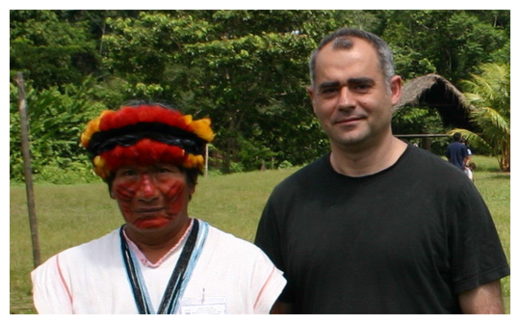
This moment in July 2014 was just one among many similar experiences Surrallés had during a total of three years living among the Candoshi since 1991. His fieldwork led Surrallés to the startling conclusion that these people simply don't have color words: reliable descriptors for the basic colors in the world around them. Candoshi children don't learn the colors of the rainbow because their community doesn't have words for them.
Though his finding might sound remarkable, Surrallés, who is with the National Center for Scientific Research in Paris, isn't the first to propose that this cultural phenomenon exists. Anthropologists in various corners of the world have reported on other small tribes who also don't seem to have a staple vocabulary for color. Yet these conclusions fly in the face of those found in the most influential book on the topic: The World Color Survey, published in 2009, which has at its very heart the hypothesis that every culture has basic color words for at least part of the rainbow.
The debate sits at the center of an ongoing war in the world of color research. On the one side stand "universalists," including the authors of The World Color Survey and their colleagues, who believe in a conformity of human perceptual experience: that all people see and name colors in a somewhat consistent way. On the other side are "relativists," who believe in a spectrum of experience and who are often offended by the very notion that a Westerner's sense of color might be imposed on the interpretation of other cultures and languages. Many researchers, like Surrallés, say they stand in the middle: While there are some universals in human perception, Surrallés argues, color terms don't seem to be among them.
It is almost incomprehensible at first to imagine that the rainbow is not viewed similarly by all people, that there might be more, or fewer, colors in the world than we thought, or that someone might not bother to give colors a name. And yet once one gets beyond the initial, startling blow of these ideas, they begin to seem obvious. There are, after all, no actual lines in a real rainbow. There's no reason to think that orange is any more or less a legitimate color than, say, cyan, or that one culture's list of colors is more "real" than another's.
Or is there?
In the early 1960s, Paul Kay met Brent Berlin. Both were anthropologists, and they each had done fieldwork for their graduate research with two totally different and unrelated peoples: Kay with Tahitians in the South Pacific and Berlin with the Tzeltal of the Mexican highlands. In comparing notes, they realized a strange coincidence. Both researchers had assumed that it would be very hard to learn the local words for colors, since the textbooks at that time said that different cultures would divide up the color spectrum essentially "on a whim," says Kay. A given culture might have any number of words for different kinds of red, for example, or not distinguish red from yellow, without much rhyme or reason. Yet both researchers had found most of the colors in the languages of the peoples they were studying to be roughly the same as in English, with one major exception: Each language had only a single word for green and blue. "We were just chatting one day and discovered we had the same experience, and we just thought, 'Wow, everything we were taught was wrong,'" remembers Kay.
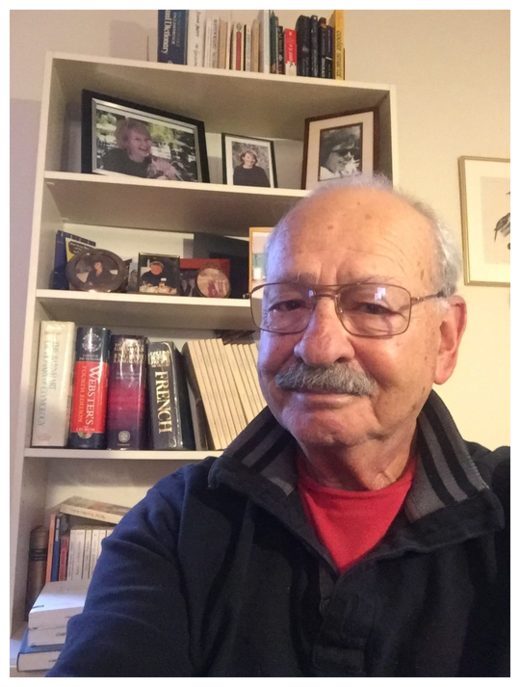
This was a startling conclusion for the world of color research. But their findings were, admittedly, based on a small sample. In the early 1970s, the two researchers met with the Summer Institute of Linguistics (now the Dallas, Texas - based SIL International), which maintained a network of linguist-missionaries around the world to help document languages, promote literacy, and translate the Bible. The institute offered to help expand Kay and Berlin's work. In the end, their missionaries gathered data on 110 unwritten languages by showing 330 different color chips to tribal people throughout the world in an attempt to learn "the smallest set of simple words with which the speaker can name any color." The result was the controversial book, The World Color Survey, which came to many of the same conclusions as its predecessor. "It's really an impressive piece of science and still the largest dataset of color vocabulary," says Asifa Majid, a language and cognition expert at Radboud University in Nijmegen, Netherlands. "It's unparalleled."
Candoshi was one of the languages in that survey. In 1979, a missionary determined that the Candoshi language belonged in a middle stage of Berlin and Kay's spectrum of color-word evolution. This Peruvian community had terms for black (kantsirpi), white (borshi), red (chobiapi), and yellow-orange (ptsiyaro). Things got murkier at the blue end of the spectrum: The word kavabana was used for the color green all the way to the color purple, but kamachpa was applied to dark green.
Surrallés disputes their summary of Candoshi color terms, having come to a conclusion that even he found surprising. When he first arrived among the Candoshi, it was obvious that they had a love of bright colors. "On a regular—if not daily—basis, the Candoshi spend much of their time making different dyes and pigments, particularly red ones, for use as face paints or to dye pottery," he wrote in an October 2016 article on the topic. "On rainy days when they cannot go hunting or fishing, they make crowns, chest adornments, and ear-rings by combining feathers ... prized for their lively, contrasting colors." And yet, he explained, the people there had no consistent, basic terms for those colors.
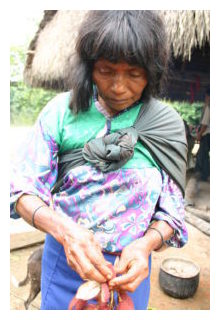
The Candoshi are now in the middle of the color debate, with some research suggesting that they lack specific words for colors.
Secondly, Surrallés found that the people he spoke to would use other words to describe color chips just as often as they used the words found in The World Color Survey. Sometimes these terms varied depending on context: If a red chip was on a ceramic surface, it was usually said to be "like ripe fruit," but if the chip was on the floor, it was more often deemed to be "like blood." And if the chip was placed under different lighting or against a new background color, again the term used to describe it would often change.
In light of the fact that the Candoshi don't even have a word for the concept of "color," Surrallés concludes that they are probably not using the words in reference to color at all but rather comparing one object to another more holistically. Kay, however, disputes these findings. He points out that The World Color Survey results mesh well with the Candoshi dictionary that was published before The World Color Survey work and arguing that just because a word is complex in meaning or syntax doesn't mean it isn't a color term.
"Of course some societies don't have a word for color," Kay adds. "There are tons of languages that have words for big and small, or hot and cold, without a word for size or temperature. Most unwritten languages don't have words for abstractions. You don't need 'em."
Berlin and Kay were hardly the first to delve into the topic of color names. The ancient Greeks believed there to be a connection among colors, musical notes, the known objects in the solar system, and the seven days of the week; the Greek philosopher Aristotle listed seven basic colors as black, white, red, yellow, green, blue, and violet. Before about the year 1500, a word for orange did not exist in the English language. It was only after orange trees were brought to Europe from Asia that the color name was born. (Prior to that it was just called "yellow-red.") In the 1600s, English physicist Sir Isaac Newton intentionally continued the tradition of sevens, listing the rainbow as the now-traditional red, orange, yellow, green, blue, indigo, and violet. (Indigo, which most people today would have a hard time identifying, was probably Newton's name for what we would now call deep blue; Newton's blue might have been what we would now call a lighter cyan.)
When looking for evidence of a universal experience of color, one might wonder if there's something hard-wired in the human eye that shapes our color perception. There doesn't seem to be a simple connection. Most of us have three types of cones, or light receptors, that are optimized to detect different colors or wavelengths of light. With these, most people can distinguish millions of distinct shades (though of course we don't have names for them all, and whether we see exactly the same things as each other is debatable).
There is, however, some biological evidence for a universal method of color division. A study of 4-month-old infants showed that they were quicker to see a green circle on a blue background than a differently colored blue on the same blue background, even though the circle colors were the same distance away from the background on the color spectrum. "I didn't believe this at first," says Majid, who replicated the effect in 8-month-old babies. Such research hints that some color categorization might be hard-wired into the brain, although it's arguable that these babies learned some color distinction from the toys and other objects around them. What you really need to do, says Majid, is replicate this study with infants from nonmanufacturing societies—ideally in environments with very different natural color palettes from each other, like a jungle and a desert—and see if they too have the same built-in categories. (If their ability to distinguish color is innate, then early exposure to a world rich in mostly green, or predominantly yellow, shouldn't alter their ability to perceive differences in hues across the spectrum.)
When looking at language rather than biology, there are some useful guidelines about what constitutes a basic color. One condition is that the color word should be simple (as in "blue," not "bluish" or "sky blue"). It should be in such common use that there is little disagreement about what it means (unlike, say, aquamarine versus turquoise). It shouldn't be subsumable by another, broader category (as in "cyan is a type of blue"). And it should be applicable to any class of objects, not just one category (the words ginger and auburn are typically used to mean "red" predominantly in reference to hair, for example). Even with such guidelines, it is easy to see how problems in interpretation arise.
In Majid's work with the Jahai of the Malay Peninsula, for example, she would put out a bunch of color chips and ask people to group the chips by which are "similar." "They would take pairs, and put red and blue together, this sort of thing," says Majid. When she and her team asked them why, they would say things like, "Husband and wife go together," she says. Such linguistic difficulties make it very hard to do this kind of work, notes Majid.
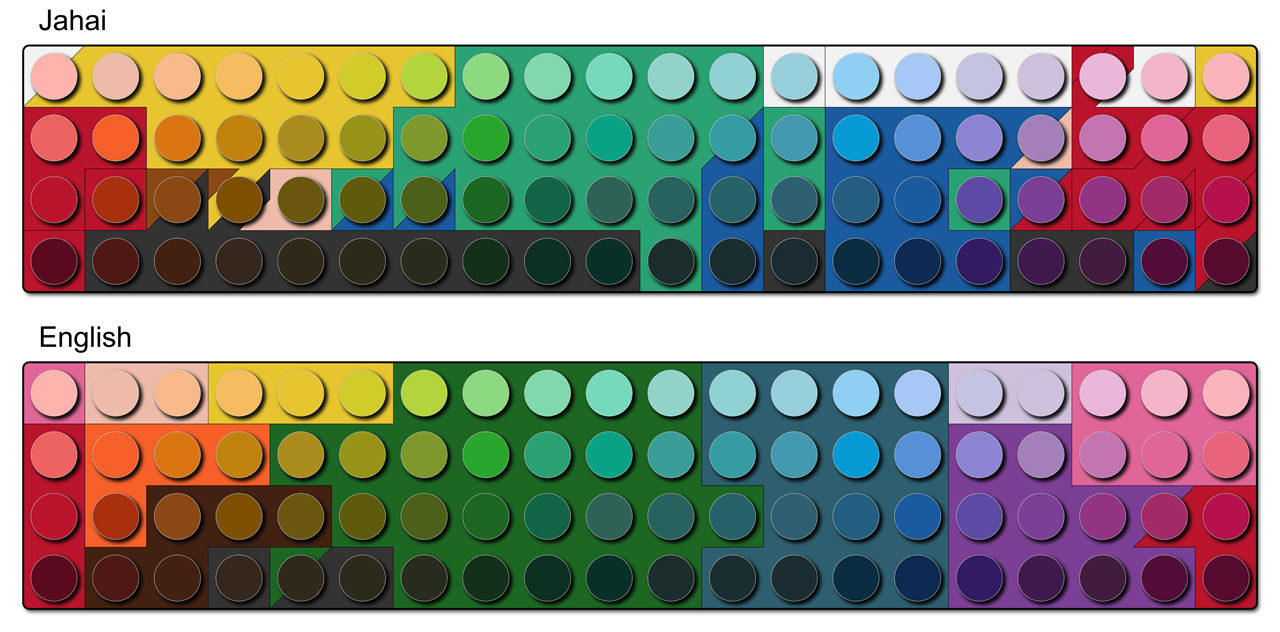
Individual cultures not only have different words to describe colors, but they also group colors together differently.
Her statement is perhaps ironic, given that Wierzbicka describes herself as perhaps the most extreme language universalist: She has proposed a set of 65 universal words or concepts ("semantic primes") that are common in all languages—but color isn't one of them. "Color is not a universal concern," Wierzbicka says. "All people use verbal resources to describe what they see," she adds. We categorize and compare but in different ways. One might group things by shininess, texture, or size; by something we have never thought of; or by all of these at once. Color is most important, she notes, in a manufacturing society, where two objects might be identical except for color (a red shirt and a blue shirt). That just doesn't happen in the natural world.
The surprise is not that people disagree about cultural perceptions of color but that the arguments become so heated. The World Color Survey "made a lot of people really mad, and some still are, after all these years," says Kay. Color is not unique in this regard; attempts to describe displays of "universal" emotions (like happiness, sadness, fear, and disgust) have proven similarly controversial.
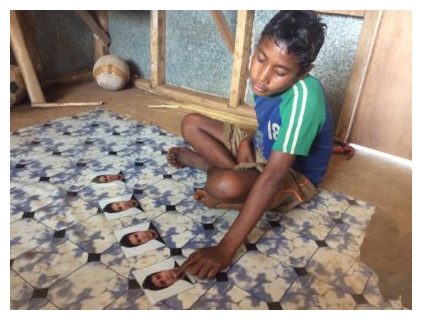
Kay acknowledges that relativists "consider the universalists to be politically suspect," but just because he believes in the universality of color experience doesn't make him colonialist or imperialist, he says. (Intriguingly, Majid's work shows that in terms of words to describe the perception of smell, English is less evolved than other languages; the Jahai language, for example, has a much more extensive vocabulary for odors.)
Kay says that taking offense at the universality of color perception for political reasons is unproductive. Some critics, he notes, even take issue with the very methodology of showing someone a simple chip of color. "There's this argument that as soon as you use color chips, you're imposing a Western framework that makes no sense to these people—you're sort of violating their culture," says Kay. But without color chips, he notes, it is extremely difficult to do a systematic, quantitative study of color perception.
The Surrallés study, Kay says, is suspect because it contains no numbers. It claims that people use multiple words for the same colors with the same frequency, but there are no statistics in the published article to support that. "You do not need a big series of numbers and sophisticated statistical calculations," to see this effect, counters Surrallés; the common use of different terms for the same color is "a very simple fact." Surrallés says instead that it is perhaps a problem if numbers are seen as so important that they become the very subject of study—it might block one's ability to more deeply explore what's really going on, he argues.
In the end, says Majid, the debate about color is really a debate about how we look at the spectrum of human cultures. "We are all really similar, but we want to celebrate what's unique about us," she says. Focusing on the similarities or the uniqueness leads to very different ways of conceptualizing the world. "They are at loggerheads," says Majid of the universalists and the relativists. "And I think both are right to some extent."
Even with all the tools of linguistics and cultural anthropology, researchers may never agree upon what people whose language has no word for color really mean when they describe a red color chip, a ripe fruit, or the fading glow of a sunset.



Reader Comments
to our Newsletter